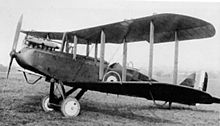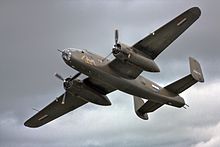- No. 98 Squadron RAF
-
No. 98 Squadron RAF Active August 1917–March 1919
February 1936–July 1941
September 1942–July 1957
August 1959–February 1976Country  UK
UKBranch  Royal Air Force
Royal Air ForceMotto Never failing Battle honours Western Front 1918
Amiens
Lys
Atlantic 1940-1941
Fortress Europe 1940-44
Normandy 1944
France & Germany 1944-45
RhineInsignia Squadron Badge heraldry Cerberus. The squadron claims to have barred the way (front and rear) during the German retreat in 1918 and so considered Cerberus, as the watchdog of Hades, a suitable badge. Squadron Codes VO, OE Aircraft flown Bomber Airco DH.9
Hawker Hind
Fairey Battle
B-25 Mitchell
de Havilland Mosquito
de Havilland Vampire
de Havilland VenomElectronic
warfareEnglish Electric Canberra Fighter Hawker Hunter No. 98 Squadron was a Royal Air Force bomber squadron during World War I and World War II. It flew fighter-bombers post-war, and converted to fighters in 1955. Reformed as an ballistic missile unit between 1959 and 1963, its final incarnation was as a radar calibration unit. It was disbanded in 1976.
Contents
History
World War I
No. 98 Squadron RFC was formed on 30 August 1917 at RFCS Harlaxton, Lincolnshire, but soon moved to Old Sarum, Wiltshire. As a day-bombing unit equipped with the Airco DH.9, it moved to Northern France in April 1918, immediately seeing action during the Battle of the Lys, and then during the Second Battle of the Marne and the Battle of Amiens. From 1 November 1918 the squadron was employed chiefly with reconnaissance work, and after the Armistice acted mainly as a holding unit for disbanding DH-9 squadrons.[1] The Squadron returned to England on 20 March 1919, and was disbanded four days later.[2]
During its active service in France the Squadron claimed 40 enemy aircraft destroyed, 35 'driven out of control', and 4 'driven down'. Thirteen aircraft of the Squadron were shot down over enemy territory, and another 13 declared missing; ten crashed or crash-landed in Allied territory and about 31 were damaged or destroyed in accidents. Nineteen men were killed in action, 22 were reported missing, 14 were wounded, 13 injured in crashes, 16 taken prisoner and five accidentally killed.[1]
Reformation
No. 98 Squadron was reformed on 17 February 1936 at Abingdon as a day-bomber squadron equipped with the Hawker Hind. In August it moved to Hucknall and in 1938 was re-equipped with the Fairey Battle.[2]
World War II
During the first nine months of World War II it served as a reserve squadron and from April–June 1940 was based at Nantes, France,[1] though it flew no combat missions. Evacuated back to England during the Battle of France, the Squadron lost 90 of its personnel when the ship RMS Lancastria was bombed and sunk off Saint-Nazaire on 17 June 1940.[2]
After re-forming at Gatwick in July 1940, the Squadron was attached to Coastal Command and stationed at Kaldadarnes, Iceland[1] for coastal patrol and anti-submarine duties. The Squadron was disbanded in July 1941, but reformed in September 1942 at West Raynham as a bomber squadron flying the B-25 Mitchell.[2]
Relocating to Foulsham in mid-October, on 22 January 1943 the Squadron made its first attack on the enemy, bombing oil installations at Terneuzen, Belgium. In August 1943 the Squadron moved to Dunsfold to take part in pre-invasion attacks on Northern France and on V1 flying bomb launching sites in the Pas-de-Calais. After the Normandy landings the Squadron operated in close support of the advancing Allied armies,[2] and from October 1944 was based at Melsbroek near Brussels, Belgium, moving to Achmer, near Osnabrück, Germany, just days prior to VE Day.[1]
Cold War
After the war the Squadron remained with the British Air Forces of Occupation in Germany until 1957. It converted to the de Havilland Mosquito in September 1945, and in February 1951, received de Havilland Vampire fighter-bombers, replacing these with the Venom in 1953. In April 1955 the Squadron received the Hawker Hunter and became a day fighter unit until disbanding on 15 July 1957.[2]
After training at Vandenberg Air Force Base,[1] the squadron was reformed - as 98(SM) Sqn. - on 1 August 1959 as one of 20 Strategic Missile (SM) squadrons associated with Project Emily. The squadron was equipped with three Thor Intermediate range ballistic missiles. and based at RAF Driffield.
In October 1962, during the Cuban missile crisis, the squadron was kept at full readiness, with the missiles aimed at strategic targets in the USSR. The squadron was disbanded on 18 April 1963 with the termination of the Thor Program in Britain.[2]
The following day the radar calibration unit No. 245 Squadron at Tangmere was renumbered as No. 98 Squadron. In October it moved its Canberras to Watton. In April 1969, it moved to Cottesmore, and was finally disbanded on 27 February 1976.[2]
References
- Notes;
- ^ a b c d e f Flt.Lt. W.R. Lambert & Flt.Lt. R.A. Brown (August 1967). "A Short History of 98 Squadron". rafjever.org. http://www.rafjever.org/98squadhistory3.htm. Retrieved 29 May 2010.
- ^ a b c d e f g h "RAF : Historic Squadrons : 98 Squadron". raf.mod.uk. http://www.raf.mod.uk/history/98squadron.cfm. Retrieved 29 May 2010.
External links
- "Traces of World War 2 - No. 98 RAF Squadron, May/June 1940". epibreren.com. http://www.epibreren.com/ww2/raf/98_squadron.html. Retrieved 29 May 2010.
- "No. 98 Squadron (RAF) during the Second World War". historyofwar.org. http://www.historyofwar.org/air/units/RAF/98_wwII.html. Retrieved 29 May 2010.
Currently active Inactive 1 · 4 · 10 · 13 · 20 · 21 · 23 · 25 · 26 · 34 · 35 · 36 · 37 · 38 · 40 · 42 · 43 · 44 · 46 · 48 · 49 · 50 · 52 · 53 · 55 · 58 · 59 · 61 · 62 · 63 · 64 · 65 · 66 · 67 · 68 · 69 · 70 · 71 · 73 · 74 · 75 · 76 · 77 · 79 · 80 · 81 · 82 · 83 · 85 · 86 · 87 · 88 · 89 · 90 · 91 · 92 · 93 · 94 · 95 · 96 · 97 · 98 · 102 · 103 · 104 · 105 · 106 · 107 · 108 · 109 · 110 · 111 · 112 · 113 · 114 · 115 · 116 · 117 · 118 · 119 · 120 · 121 · 122 · 123 · 124 · 125 · 126 · 127 · 128 · 129 · 130 · 131 · 132 · 133 · 134 · 135 · 136 · 137 · 138 · 139 · 140 · 141 · 142 · 143 · 144 · 145 · 146 · 147 · 148 · 149 · 150 · 151 · 152 · 153 · 154 · 155 · 156 · 157 · 158 · 159 · 160 · 161 · 162 · 163 · 164 · 165 · 166 · 167 · 168 · 169 · 170 · 171 · 172 · 173 · 174 · 175 · 176 · 177 · 178 · 179 · 180 · 181 · 182 · 183 · 184 · 185 · 186 · 187 · 188 · 189 · 190 · 191 · 192 · 193 · 194 · 195 · 196 · 197 · 198 · 199 · 200 · 201 · 204 · 205 · 209 · 210 · 211 · 212 · 213 · 214 · 215 · 217 · 218 · 219 · 220 · 221 · 222 · 223 · 224 · 225 · 226 · 227 · 228 · 229 · 231 · 232 · 233 · 234 · 235 · 236 · 237 · 238 · 239 · 240 · 241 · 242 · 243 · 244 · 245 · 246 · 247 · 248 · 249 · 250 · 251 · 252 · 253 · 254 · 255 · 256 · 257 · 258 · 259 · 260 · 261 · 262 · 263 · 264 · 265 · 266 · 267 · 268 · 269 · 270 · 271 · 272 · 273 · 274 · 275 · 276 · 277 · 278 · 279 · 280 · 281 · 282 · 283 · 284 · 285 · 286 · 287 · 288 · 289 · 290 · 291 · 292 · 293 · 294 · 295 · 296 · 297 · 298 · 299 · 353 · 354 · 355 · 356 · 357 · 358 · 360 · 361 · 510 · 511 · 512 · 513 · 514 · 515 · 516 · 517 · 518 · 519 · 520 · 521 · 524 · 525 · 526 · 527 · 528 · 529 · 530 · 531 · 532 · 533 · 534 · 535 · 536 · 537 · 538 · 539 · 540 · 541 · 542 · 543 · 544 · 547 · 548 · 549 · 550 · 567 · 569 · 570 · 571 · 575 · 576 · 577 · 578 · 582 · 586 · 587 · 595 · 597 · 598 · 618 · 619 · 620 · 621 · 622 · 623 · 624 · 625 · 626 · 627 · 628 · 629 · 630 · 631 · 635 · 639 · 640 · 644 · 650 · 651 · 652 · 653 · 654 · 655 · 656 · 657 · 658 · 659 · 660 · 661 · 662 · 663 · 664 · 665 · 666 · 667 · 668 · 669 · 670 · 671 · 672 · 673 · 679 · 680 · 681 · 682 · 683 · 684 · 691 · 692 · 695
Australian Flying Corps (AFC) units attached
to the RAF during the First World WarCommonwealth air force units attached to
the RAF during the Second World War.Squadrons formed from non-Commonwealth
personnel during the Second World WarArgentineBelgian349 · 350CzechoslovakDutchFrenchGreek335 · 336NorwegianYugoslavRoyal Auxiliary Air Force Special ReserveAuxiliary Air ForceFleet Air Arm of the RAF (1924–1939) Royal Air Force portal Formations and units Commands · Groups · Stations · Wings · Aircraft squadrons · Aircraft flights · Conversion units · Regiment squadrons

Branches and components RAF Regiment · RAF Chaplains Branch · RAF Intelligence · RAF Legal Branch · Princess Mary's RAF Nursing Service · RAF Police · Search and Rescue Force · Mountain Rescue Service
Reserve forces Associated civil organizations Air Training Corps · RAF Association · RAF Centre of Aviation Medicine
Equipment List of RAF aircraft · List of RAF missiles
Personnel Symbols and uniform History · Timeline · Future Categories:- Royal Flying Corps squadrons
- Royal Air Force aircraft squadrons
- Military units and formations established in 1917
- Military units and formations disestablished in 1976
- Military units and formations of the Royal Air Force in World War I
- Military units and formations of the Royal Air Force in World War II
- 1917 establishments in the United Kingdom
Wikimedia Foundation. 2010.




